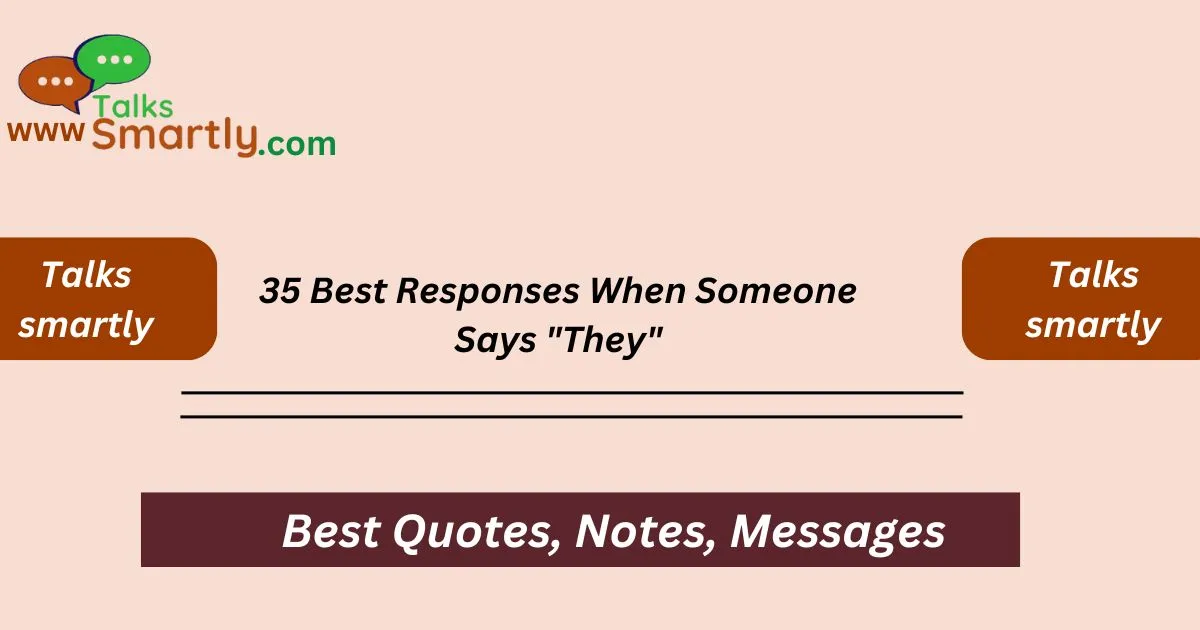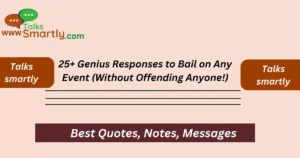“Discover the best ways to respond when someone says “they” to enhance your conversations.”
When someone refers to a group or an unknown subject with the term “they,” it can leave you puzzled or searching for the right words. Understanding how to respond appropriately can help clarify the conversation and strengthen your communication skills.
In today’s world, the way we interact matters more than ever. Whether it’s in casual chats or serious discussions, responding thoughtfully can make a big difference. If you’re unsure how to react when someone says “they,” don’t worry. This blog post will equip you with 35 powerful responses that can help you navigate various situations with ease.
Here, you’ll find clear examples and useful explanations for each response. This guide aims to enhance your conversational abilities and ensure you feel confident in your replies. Let’s dive in!
Responses When Someone Says “They”
- Clarification request
- Seek examples
- Open-ended question
- Agree and expand
- Express confusion
- Suggest alternatives
- Ask for context
- Share your opinion
- Reflect their statement
- Inquire about intentions
- Confirm understanding
- Mention the importance of specificity
- Explore their perspective
- Suggest follow-up discussion
- Connect to a similar topic
- Offer to brainstorm
- Acknowledge the complexity
- Encourage elaboration
- Clarify the subject matter
- Point out the ambiguity
- Make a light-hearted comment
- Share a personal experience
- Thank them for sharing
- Suggest focusing on one topic
- Acknowledge different viewpoints
- Express interest in learning more
- Recommend further reading
- Emphasize mutual understanding
- Ask for their reasoning
- Introduce related themes
- Show empathy
- Validate their feelings
- Challenge assumptions
- Encourage collaboration
- Remain neutral
1. Clarification Request
When someone says “they,” it’s often unclear who or what they are talking about. A great response is to ask for clarification. This shows that you are engaged and want to understand better.
Example: “Who do you mean by ‘they’? Can you clarify a bit?”
2. Seek Examples
You can encourage the speaker to provide examples. This can make their statement clearer and more relatable.
Example: “Can you give me an example of what you mean by ‘they’?”
3. Open-Ended Question
Asking an open-ended question can invite the speaker to elaborate on their thoughts, leading to a more in-depth discussion.
Example: “What do you think about their approach?”
4. Agree and Expand
If you agree with their statement, express it and then expand on it to share your thoughts.
Example: “I agree with what they said about teamwork. It’s essential for success.”
5. Express Confusion

If you’re confused, don’t hesitate to say so. Expressing confusion can lead to more insightful conversations.
Example: “I’m not quite sure I follow. Can you explain what you mean?”
6. Suggest Alternatives
Sometimes, you might have a different perspective. Suggesting alternatives can enrich the dialogue.
Example: “They could be right, but have you considered this viewpoint?”
7. Ask for Context
Requesting context can help you understand the background of their statement.
Example: “What’s the context behind what they mentioned?”
8. Share Your Opinion
If you have a relevant opinion, share it. This can foster a more engaging discussion.
Example: “In my view, they have a valid point, especially regarding the importance of communication.”
9. Reflect Their Statement
Repeating or reflecting back what they said can show that you are listening and encourage them to elaborate.
Example: “So you think they’re not considering all factors?”
Dirty Pick-Up Lines: A Funny Collection
10. Inquire About Intentions
Understanding their intentions can provide deeper insight into the discussion.
Example: “What do you think their intention was when they said that?”
11. Confirm Understanding
Before responding, confirm that you understand their point correctly.
Example: “Just to confirm, you mean that they are taking a different approach, right?”
12. Mention the Importance of Specificity
Emphasizing the need for specificity can improve clarity in the conversation.
Example: “I think it’s important to be specific about who they are talking about.”
13. Explore Their Perspective
Show interest in their viewpoint by asking them to explore it further.
Example: “How do you see their perspective on this matter?”
14. Suggest Follow-Up Discussion
If the topic is complex, suggest a follow-up discussion for deeper exploration.
Example: “This is an interesting topic; maybe we can discuss it more later?”
15. Connect to a Similar Topic
Finding a connection to a similar topic can enrich the conversation.
Example: “That reminds me of a situation where they had a different viewpoint.”
16. Offer to Brainstorm
Invite collaboration by offering to brainstorm ideas together.
Example: “Let’s brainstorm some solutions regarding what they mentioned.”
17. Acknowledge the Complexity
Recognizing the complexity of the topic shows that you appreciate its nuances.
Example: “This topic is quite complex, especially considering different viewpoints they might have.”
18. Encourage Elaboration
Prompt the speaker to elaborate on their statement to foster a deeper conversation.
Example: “Can you elaborate on why you feel that way about them?”
19. Clarify the Subject Matter
Help clarify the subject matter for better understanding.
Example: “Can you clarify what specific issue they are referring to?”
20. Point Out the Ambiguity
Sometimes it helps to point out the ambiguity in their statement.
Example: “I find the term ‘they’ a bit ambiguous; can we specify it?”
21. Make a Light-Hearted Comment
Adding a bit of humor can lighten the mood and make the conversation more enjoyable.
Example: “They must be a busy group if they’re always in the conversation!”
22. Share a Personal Experience
Relating a personal experience can make the conversation more relatable.
Example: “I once faced a similar situation when they didn’t communicate well.”
23. Thank Them for Sharing
Showing appreciation for their input can encourage open communication.
Example: “Thanks for sharing that; it gives me something to think about!”
24. Suggest Focusing on One Topic
Encourage focusing on one specific topic to enhance clarity.
Example: “Maybe we should focus on one aspect of what they said for now.”
25. Acknowledge Different Viewpoints
Recognizing that there are different viewpoints can foster understanding.
Example: “I appreciate that there are various viewpoints about what they might mean.”
26. Express Interest in Learning More
Showing interest can encourage the speaker to share more information.
Example: “I’d love to learn more about what they think on this issue.”
27. Recommend Further Reading
Suggesting resources can help deepen understanding.
Example: “I recommend reading more about their perspectives in this area.”
28. Emphasize Mutual Understanding

Highlighting the importance of mutual understanding can strengthen the conversation.
Example: “It’s essential that we understand where they’re coming from.”
29. Ask for Their Reasoning
Inquiring about their reasoning can shed light on their perspective.
Example: “What led them to that conclusion?”
30. Introduce Related Themes
Bringing up related themes can enrich the discussion.
Example: “This relates to the theme of communication in teamwork, which they also mentioned.”
31. Show Empathy
Showing empathy can create a more supportive conversation environment.
Example: “I can see why they might feel that way given the circumstances.”
32. Validate Their Feelings
Acknowledging and validating their feelings can strengthen the relationship.
Example: “It’s valid to feel that way about their comments; many people do.”
33. Challenge Assumptions
If necessary, challenge any assumptions to encourage critical thinking.
Example: “Are we sure that what they said is accurate?”
34. Encourage Collaboration
Encouraging collaboration can lead to new insights and solutions.
Example: “Let’s collaborate on finding a solution to what they pointed out.”
35. Remain Neutral
Sometimes, it’s best to remain neutral and simply listen.
Example: “I appreciate your perspective; I’m here to listen.”
Answer the key Question
What does it mean when someone uses “they”?
“They” can refer to a group, an unspecified person, or be used in discussions about gender identity. Understanding the context is essential.
How can I respond if I’m unsure what “they” refers to?
It’s perfectly okay to ask for clarification or examples to better understand the conversation.
Why is it important to respond thoughtfully?
Thoughtful responses foster better communication, showing respect and understanding for others’ perspectives.
Can humor help when responding?
Yes, a light-hearted comment can ease tension and make the conversation more enjoyable.
What if I disagree with what “they” said?
You can express your opinion respectfully and suggest alternatives or seek more information to understand their viewpoint better.
Conclusion
Responding effectively when someone says “they” is essential for clear and engaging communication. With the 35 responses outlined above, you now have a toolkit to help you navigate these situations with confidence.
By asking questions, expressing curiosity, and sharing your insights, you can enhance your conversations and build stronger connections. Remember, communication is a two-way street, and fostering understanding is key to any dialogue.











